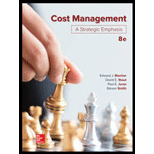
1.
Draft an income statement using full costing
1.
Explanation of Solution
Statement of income statement under full cost method:
| Particulars | Prior year | Current year | ||
| Amount ($) | Amount ($) | Amount ($) | Amount ($) | |
| Sales (1) | 1,320,000 | 1,430,000 | ||
| Less: Cost of goods sold | ||||
| Beginning inventory | - | 24,000 | ||
| Cost of goods produced (2) | 600,000 | 600,000 | ||
| Available for sale | 600,000 | 624,000 | ||
| Less: Ending inventory | 24,000(3) | - | ||
| Cost of goods sold | 576,000 | 624,000 | ||
| Gross margin | 744,000 | 806,000 | ||
| Less: Selling and administrative cost | ||||
| Variable (4) | 12,000 | 13,000 | ||
| Fixed | 500 | 12,500 | 500 | 13,500 |
| Operating income | 731,500 | 792,500 | ||
Table (1)
Therefore, the operating income for the prior year is $731,500 and for the current year is $792,500 respectively
Working notes:
1) Calculate the amount of sales:
For prior year
For current year:
2) Calculate the amount of cost of goods sold:
For prior year:
For current year:
3) Calculate the ending inventory:
For the prior period:
4) Calculate the variable cost:
For prior period:
For current period:
2.
Draft an income statement under variable costing.
2.
Explanation of Solution
Statement of income statement under variable cost method:
| Particulars | Prior year | Current year | ||
| Amount ($) | Amount ($) | Amount ($) | Amount ($) | |
| Sales (1) | 1,320,000 | 1,430,000 | ||
| Less: Cost of goods sold | ||||
| Beginning inventory | - | 16,000 | ||
| Cost of goods produced (5) | 400,000 | 400,000 | ||
| Available for sale | 400,000 | 416,000 | ||
| Less: Ending inventory | 16,000(6) | - | ||
| Cost of goods sold | 384,000 | 416,000 | ||
| Plus: Variable selling (4) | 12,000 | 396,000 | 13,000 | 429,000 |
| Contribution Margin | 924,000 | 1,001,000 | ||
| Less: Fixed | 200,000 | 200,000 | ||
| Fixed selling costs | 500 | 200,500 | 500 | 200,500 |
| Operating income | 723,500 | 800,500 | ||
Table (2)
Therefore, the operating income for the prior year is $723,500 and for the current year is $800,500 respectively.
Working notes:
5) Calculate the cost of goods sold:
For prior period:
For current period:
6) Calculate the closing inventory:
For prior period:
3.
Prepare
3.
Explanation of Solution
Statement of reconciliation showing the difference in operating income:
| Particulars | Prior year | Current year |
| Change in inventory (a) | 1,000 | (1,000) |
| Fixed | $8.00 | $8.00 |
| Difference in operating income (a x b) | $8,000 | ($8,000) |
Table (3)
Therefore, the change in operating income for the prior year is $8,000 increase and for the current year is $8,000 decrease.
An increase in inventory units shows the income of full costing higher than the variable costing, since there is excess of fixed cost in inventory than the previous year.
When the inventory unit decreases, the operating income of variable costing is higher than full costing. Here, as the inventory decreases the operating income for variable costing is higher than the full costing.
Want to see more full solutions like this?
Chapter 18 Solutions
Cost Management
- Compute the estimated inventory on June 30arrow_forwardHow can I solve this financial accounting problem using the appropriate financial process?arrow_forwardIf $7,500 was the beginning inventory, purchases were $16,200, and cost of goods sold were $15,300, how much was the ending inventory last accounting period? helparrow_forward
- Can you solve this general accounting problem using appropriate accounting principles?arrow_forwardIf the contribution margin ratio for Victory Electronics is 35%, sales were $2,450,000, and fixed costs were $712,500, what was the income from operations?arrow_forwardI need help with this general accounting question using the proper accounting approach.arrow_forward
- I am looking for the most effective method for solving this financial accounting problem.arrow_forwardThe financial statements of the Patterson Industries reported net sales of $875,000 and accounts receivable of $95,000 and $65,000 at the beginning of the year and end of the year, respectively. What is the receivables turnover ratio for Patterson? Need helparrow_forwardA firm has net working capital of $1,450, net fixed assets of $5,220, sales of $12,750, and current liabilities of $1,880. How many dollars worth of sales are generated from every $1 in total assets? a. $2.92 b. $1.49 c. $2.36 d. $1.50 e. $1.37arrow_forward

 AccountingAccountingISBN:9781337272094Author:WARREN, Carl S., Reeve, James M., Duchac, Jonathan E.Publisher:Cengage Learning,
AccountingAccountingISBN:9781337272094Author:WARREN, Carl S., Reeve, James M., Duchac, Jonathan E.Publisher:Cengage Learning, Accounting Information SystemsAccountingISBN:9781337619202Author:Hall, James A.Publisher:Cengage Learning,
Accounting Information SystemsAccountingISBN:9781337619202Author:Hall, James A.Publisher:Cengage Learning, Horngren's Cost Accounting: A Managerial Emphasis...AccountingISBN:9780134475585Author:Srikant M. Datar, Madhav V. RajanPublisher:PEARSON
Horngren's Cost Accounting: A Managerial Emphasis...AccountingISBN:9780134475585Author:Srikant M. Datar, Madhav V. RajanPublisher:PEARSON Intermediate AccountingAccountingISBN:9781259722660Author:J. David Spiceland, Mark W. Nelson, Wayne M ThomasPublisher:McGraw-Hill Education
Intermediate AccountingAccountingISBN:9781259722660Author:J. David Spiceland, Mark W. Nelson, Wayne M ThomasPublisher:McGraw-Hill Education Financial and Managerial AccountingAccountingISBN:9781259726705Author:John J Wild, Ken W. Shaw, Barbara Chiappetta Fundamental Accounting PrinciplesPublisher:McGraw-Hill Education
Financial and Managerial AccountingAccountingISBN:9781259726705Author:John J Wild, Ken W. Shaw, Barbara Chiappetta Fundamental Accounting PrinciplesPublisher:McGraw-Hill Education





